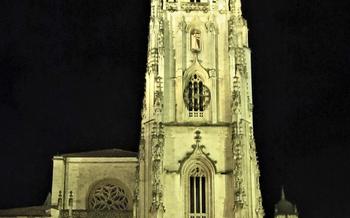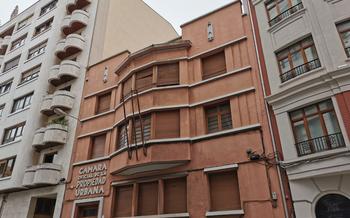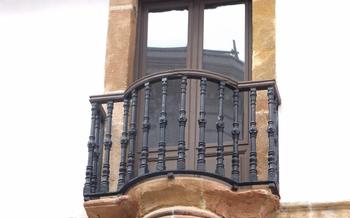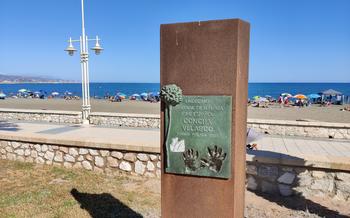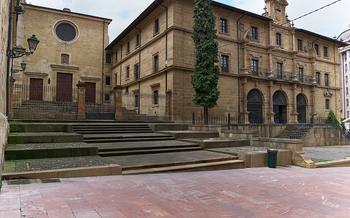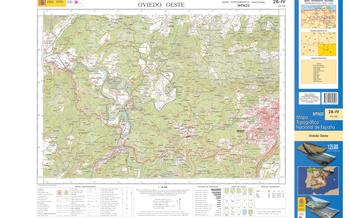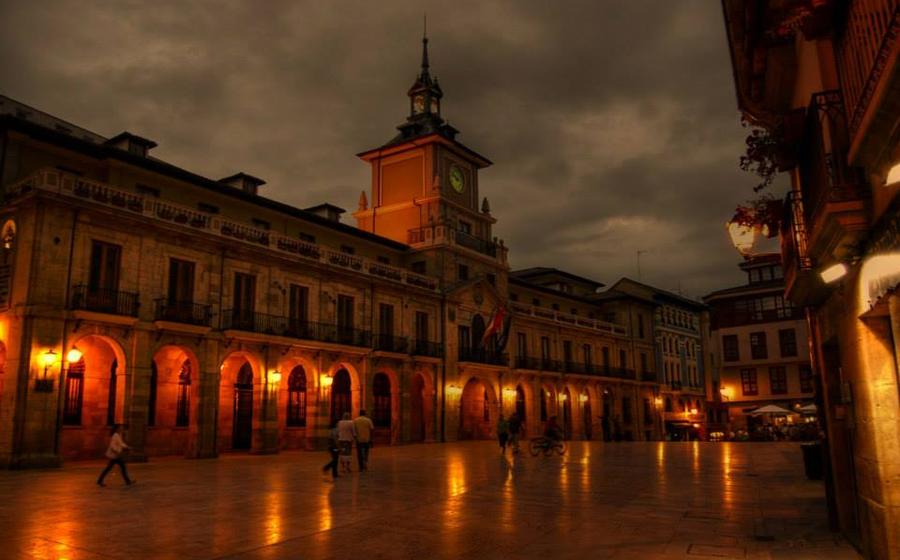
Ayuntamiento de Oviedo
- Gothic Masterpiece: Delving into the Architectural Details
- A Walk Through Time: Exploring the History of Oviedo City Hall
- Inside the Ayuntamiento: Discover the Grand Hall and More
- Admire the Tower of Oviedo City Hall
- The Clock of Oviedo City Hall: A Symbol of Precision
- The Coat of Arms: A Symbol of Oviedo's Identity
- The Figuren: Guardians of Oviedo City Hall
- The Balcony: A Stage for Celebrations and Proclamations
- Plaza de la Constitución: A Historical Square Next Door
- The Battle of Oviedo: A Pivotal Event in History
- Cultural Events and Exhibitions
- Practical Information for Visitors
- Insider Tip: Join the Local Festivities
Gothic Masterpiece: Delving into the Architectural Details
The Ayuntamiento de Oviedo stands as a testament to the grandeur of Gothic architecture, showcasing a harmonious blend of intricate carvings, soaring spires, and ornate details. The façade, the most striking feature of the building, is a masterpiece of Gothic artistry. Its central doorway is flanked by two slender towers, their pinnacles reaching towards the sky like celestial fingers. Above the doorway, a beautiful rose window adds a touch of lightness and elegance to the otherwise imposing façade.
One of the most captivating elements of the façade is the intricate carvings that adorn every nook and cranny. From delicate floral motifs to intricate scenes depicting biblical stories, the carvings tell a visual narrative of the city's history and religious beliefs. The attention to detail is simply astonishing, with each figure and ornament seemingly crafted with the utmost care and precision.
The Ayuntamiento de Oviedo's Gothic style is further emphasized by its use of pointed arches, ribbed vaults, and flying buttresses. The interior of the building is equally impressive, with its vaulted ceilings and stained-glass windows creating a sense of awe and wonder. The overall effect is one of grandeur and majesty, a fitting tribute to the city of Oviedo and its rich cultural heritage.
A Walk Through Time: Exploring the History of Oviedo City Hall
Oviedo City Hall, a venerable edifice that has stood the test of time, boasts a rich and fascinating history. Its origins can be traced back to the 17th century when the city fathers sought to construct a grand structure that would serve as the seat of local government. The task of designing and overseeing the project fell upon the renowned architect Juan de Naveda, who envisioned a magnificent building that would reflect the grandeur and prestige of the city.
Over the centuries, Oviedo City Hall has undergone several transformations and additions, each reflecting the changing needs and aspirations of the city. In the 18th century, the façade was embellished with intricate carvings and sculptures, lending it a distinctly Baroque character. The clock tower, a prominent feature of the building, was added in the 19th century, symbolizing the city's embrace of modernity and progress.
Throughout its history, Oviedo City Hall has played a pivotal role in local government and politics. It has served as the venue for countless meetings, debates, and decisions that have shaped the destiny of the city. Within its walls, generations of city officials have worked tirelessly to improve the lives of their citizens, addressing issues ranging from urban planning and infrastructure to social welfare and cultural development.
In recent years, Oviedo City Hall has undergone extensive restoration and conservation efforts, ensuring its preservation for future generations. The building's historic character has been meticulously maintained, while modern amenities have been carefully integrated to enhance its functionality and accessibility. Today, Oviedo City Hall stands as a testament to the city's rich heritage and its ongoing commitment to progress and innovation.
Inside the Ayuntamiento: Discover the Grand Hall and More
Step inside Oviedo City Hall, and you'll be greeted by a world of grandeur and history. The interior spaces are as impressive as the exterior, with soaring ceilings, intricate carvings, and elegant décor. The highlight is undoubtedly the Grand Hall, a masterpiece of Gothic architecture. This vast chamber has witnessed countless important events throughout Oviedo's history, from political debates to royal ceremonies. Its walls are adorned with stunning frescoes, stained-glass windows, and intricate carvings that tell tales of the city's rich past.
Other notable features of the interior include the Council Chamber, where local government officials meet to discuss and make decisions affecting the city. The Sala de Juntas, with its beautiful wooden ceiling and ornate chandeliers, is another highlight. Visitors can also explore various exhibition spaces that showcase Oviedo's history, culture, and art. Whether you're interested in learning about the city's political system, admiring its artistic treasures, or simply soaking up the grandeur of a bygone era, the interior of Oviedo City Hall is a must-see for any visitor.
Admire the Tower of Oviedo City Hall
Towering Over History: The Majestic Tower of Oviedo City Hall
Ascend the steps to the tower of Oviedo City Hall, a symbol of resilience and architectural prowess. Standing tall at 35 meters, the tower offers panoramic views that will leave you breathless. Gaze upon the picturesque city of Oviedo, with its vibrant streets, lush parks, and the distant mountains forming a stunning backdrop.
Originally built as a watchtower, the tower served as a strategic vantage point to monitor the surrounding area. Its sturdy construction has withstood the test of time, and it remains a symbol of Oviedo's rich history and heritage.
Climb to the observation deck to experience the city from a unique perspective. Take in the breathtaking vistas of the Asturian countryside, with rolling hills, lush forests, and shimmering rivers stretching out before you.
The tower's historical significance is deeply intertwined with the city's identity. It has witnessed countless events and transformations, from medieval battles to modern-day celebrations. As you stand atop the tower, let your imagination wander back in time and picture the scenes that have unfolded over the centuries.
Access to the tower is available during regular opening hours, and a small fee is required. Be sure to check the schedules for guided tours, which offer insights into the tower's history and architectural features.
The Clock of Oviedo City Hall: A Symbol of Precision
In the heart of Oviedo City Hall, the clock stands as a symbol of precision and reliability. Its intricate mechanism, crafted by skilled artisans, has been meticulously ticking away the hours for centuries. The clock's gleaming hands and ornate numerals, set against a backdrop of intricate carvings, command attention and admiration.
The clock's chimes, echoing through the cobblestone streets of Oviedo, are a familiar sound to locals and visitors alike. Every hour, the clock's melodious tune fills the air, a gentle reminder of the passage of time and the enduring spirit of this historic city.
According to local tradition, the clock's chimes hold a special significance. It is said that if you happen to hear the clock strike as you pass by, good luck will follow you throughout the day. This superstition adds an element of charm and whimsy to the clock, making it more than just a timekeeper but also a source of local pride and folklore.
The Coat of Arms: A Symbol of Oviedo's Identity
Emblazoned on the façade of Oviedo City Hall, the coat of arms stands as a proud symbol of the city's rich history and unique identity. This intricate artwork, crafted with precision and artistry, encapsulates the essence of Oviedo's heritage and its enduring spirit.
The coat of arms features a shield divided into four quadrants, each adorned with distinct elements that pay homage to the city's past. The upper left quadrant showcases a golden cross on a red background, representing the city's deep-rooted Christian faith and its role as a pilgrimage stop on the Camino de Santiago. In the upper right quadrant, a silver sword and a golden crescent moon symbolize Oviedo's victory over the Moors during the Reconquista.
The lower left quadrant displays a blue background with three silver fleur-de-lis, representing the city's close ties to the French monarchy and its role as a royal seat during the Middle Ages. Finally, the lower right quadrant features a silver castle on a red background, symbolizing the city's status as a fortified town and its strategic importance in the defense of the region.
Together, these elements create a visual narrative that encapsulates Oviedo's diverse history, its religious significance, its military prowess, its royal connections, and its role as a fortified stronghold. The coat of arms is not just a decorative element; it is a tangible representation of Oviedo's identity, a symbol of pride and belonging for its citizens, and a reminder of the city's enduring legacy.
The Figuren: Guardians of Oviedo City Hall
Adorning the façade of Oviedo City Hall, you'll find a series of intriguing sculptures known as the "Figuren." These enigmatic figures, each possessing unique characteristics, serve as silent witnesses to the history and traditions of Oviedo.
Crafted with intricate detail, the Figuren represent various figures from mythology, history, and local lore. Among them, you'll find the mythical Asturian "Nuberu," a mischievous cloud-dwelling creature, the Roman goddess Minerva, symbolizing wisdom and warfare, and the legendary King Pelayo, founder of the Kingdom of Asturias.
The placement of the Figuren is not merely ornamental; it holds symbolic significance. Positioned at strategic points on the façade, they seem to guard and protect the building, embodying the spirit and heritage of Oviedo.
Local legends and stories have grown around these enigmatic figures, adding to their allure. One tale speaks of the Figuren coming to life at night, patrolling the streets of Oviedo and ensuring the city's safety.
While the exact origins and symbolism of the Figuren remain shrouded in mystery, they have become an integral part of Oviedo's identity. These statues, frozen in time, stand as guardians of the city's history and cultural heritage, inviting visitors to delve into the rich tapestry of Oviedo's past.
The Balcony: A Stage for Celebrations and Proclamations
In the heart of Oviedo City Hall, the balcony stands as a prominent feature, overlooking the bustling Plaza del Ayuntamiento. This architectural element is not merely a decorative feature but holds significant historical and cultural importance. Throughout the centuries, the balcony has served as a stage for celebrations, proclamations, and public gatherings that have shaped the city's identity.
One of the most notable events associated with the balcony is the annual proclamation of the Fiestas de San Mateo, Oviedo's grandest festival. During this joyous occasion, the city's mayor steps onto the balcony to officially kick off the festivities, igniting a wave of excitement and anticipation among the gathered crowd below.
Beyond festivals, the balcony has also witnessed countless historical proclamations and announcements. In times of triumph, victory, and mourning, the mayor or other dignitaries would address the citizenry from this elevated platform, sharing news, expressing gratitude, or offering words of comfort. The balcony has thus become a symbol of unity and connection between the city's leaders and its residents.
Moreover, the balcony has served as a stage for public speeches, political debates, and cultural performances. Renowned figures, both local and international, have graced this platform to share their thoughts, ideas, and artistic creations with the people of Oviedo. From political rallies to poetry readings, the balcony has hosted a diverse range of events, contributing to the city's vibrant cultural landscape.
As you gaze upon the balcony of Oviedo City Hall, imagine the echoes of history that reverberate within its walls. Picture the jubilant crowds below, the speeches that have stirred hearts and minds, and the momentous announcements that have shaped the course of the city's history. This balcony is not just a structural element but a living testament to Oviedo's rich past and its enduring spirit of celebration, unity, and cultural expression.
Plaza de la Constitución: A Historical Square Next Door
In the immediate vicinity, also known as Plaza Vieja ("Old Square"), is a treasure trove of historical significance and architectural beauty.
The square dates back to the 13th century and served as the main market square for centuries. It was a bustling hub of activity where merchants and traders from across the region gathered to buy and sell goods. The buildings surrounding the square reflect the architectural styles of different eras, from medieval to Renaissance and Baroque.
Notable landmarks in the Plaza de la Constitución include the Palacio de Valdecarzana-Heredia, a 16th-century palace that currently houses the Universidad de Oviedo's Law School, and the Iglesia de San Isidoro el Real, a Gothic church dating back to the 13th century.
Plaza de la Constitución and Oviedo City Hall are inextricably linked, as the square has witnessed countless historical events and celebrations that have shaped the identity of Oviedo. It's a place where the past and present converge, creating a vibrant atmosphere that captivates visitors and locals alike.
The Battle of Oviedo: A Pivotal Event in History
In the annals of Oviedo's history, the Battle of Oviedo stands as a pivotal event that shaped the city's destiny. This fierce clash occurred in 1808, during the Peninsular War, when French troops led by Marshal Ney laid siege to the city. The citizens of Oviedo, armed with unwavering determination and a deep sense of patriotism, rose up in defense of their homeland.
Oviedo City Hall played a crucial role in the battle, serving as a symbol of resistance and a rallying point for the city's defenders. The building's sturdy walls provided shelter and protection to the besieged citizens, who fought valiantly against the overwhelming force of the French army. Despite the disparity in numbers and resources, the indomitable spirit of the Ovetenses ultimately prevailed.
The Battle of Oviedo ended with the victorious expulsion of the French troops, marking a significant turning point in the war. The city's heroic resistance became a source of inspiration for the entire region, demonstrating the resilience and fortitude of the Asturian people. To this day, the battle is commemorated with pride and remembrance, serving as a reminder of the sacrifices made in defense of freedom and independence.
Cultural Events and Exhibitions
Oviedo City Hall is not only a historical and architectural masterpiece but also a vibrant cultural hub that hosts a plethora of events and exhibitions throughout the year. These events showcase the rich artistic heritage of Oviedo and offer visitors a unique opportunity to immerse themselves in the local culture.
From captivating art exhibitions featuring the works of renowned local and international artists to mesmerizing concerts, performances, and lectures, Oviedo City Hall has something for everyone. The Grand Hall, with its stunning architecture and acoustics, serves as the perfect venue for these cultural events, creating an unforgettable experience for attendees.
Seasonal events and festivals, such as the Oviedo International Film Festival and the Christmas Market, add to the lively atmosphere of the City Hall. These events attract visitors from all over the region, creating a festive ambiance that spills out into the surrounding streets and squares.
Whether you're an art enthusiast, a music lover, or simply someone who enjoys experiencing local culture, Oviedo City Hall offers a diverse range of events and exhibitions that will enrich your visit to this historic city. Be sure to check the official website or inquire at the tourist information center for the latest schedule of events during your stay.
Practical Information for Visitors
To fully appreciate the grandeur of Oviedo City Hall, plan your visit during its opening hours, typically from Monday to Friday during business hours. Guided tours are available to enhance your experience and provide insights into the history and significance of the building. These tours are offered in various languages and can be booked in advance or upon arrival.
The Ayuntamiento de Oviedo is wheelchair accessible, ensuring that visitors with disabilities can conveniently explore its interior spaces. Detailed information about accessibility features and facilities is available on the official website or by contacting the tourist information center.
Before your visit, check the website for any special events or exhibitions that may be taking place during your stay. This will allow you to plan your itinerary accordingly and make the most of your time in Oviedo.
Insider Tip: Join the Local Festivities
To truly immerse yourself in the spirit of Oviedo and its historic City Hall, don't miss the chance to participate in one of the many local festivals and celebrations held throughout the year. These events offer a unique opportunity to experience the city's vibrant culture, traditions, and warm hospitality.
One of the most popular festivals is the San Mateo Festival, held in September. The city comes alive with colorful parades, traditional music performances, and a lively market showcasing local crafts and delicacies. Join the locals in dancing to the rhythm of bagpipes and drums, and indulge in the flavors of Asturian cuisine at the many food stalls.
Another highlight is the International Theater Festival, held in October. This prestigious event attracts renowned theater companies from around the world, showcasing innovative and thought-provoking productions. Take advantage of the opportunity to see world-class performances at Oviedo City Hall's own theater, the Campoamor Theater.
If you happen to be in Oviedo during the Christmas season, be sure to visit the City Hall's stunning nativity scene, which is considered one of the most elaborate and beautiful in Spain. The intricate display of figurines and miniature landscapes is a testament to the city's deep-rooted traditions and craftsmanship.
To fully embrace the local festivities, don't hesitate to strike up conversations with the friendly locals. They'll be more than happy to share stories, recommendations, and tips for making the most of your visit. Whether you're a history buff, an art enthusiast, or simply looking for an unforgettable cultural experience, Oviedo City Hall and its surroundings offer something for everyone.
